6.0 Russia 
 |
Reactor Types in Russia
|
Russia has 30 operating reactors at nine nuclear power plants. Together, these reactors produced 14 percent of the electricity generated in Russia in 1999. All the plants work with the United States in cooperative safety efforts. In addition, Rostov, a new plant with one VVER-1000 reactor, was scheduled for completion in early 2001. The Russian Minister of Energy has indicated that construction on two other projects that had been on hold, Kursk Unit 5 and Kalinin Unit 3, will be restarted with completion scheduled for 2003 and 2004, respectively.
Russia's 30 reactors represent four designs, as identified in the figure below. The cooperative work focuses on the two major designs-RBMKs and VVERs-which make up nearly all of Russia's nuclear power plants. Plants representing the other two designs (BN-600 and LWGR-12) began working with the United States on joint safety projects in 1996.
The United States has worked closely with Russian organizations responsible for the design, construction, operation, and regulation of nuclear power plants. A National Nuclear Security Administration office in Moscow provides administrative, technical, and contractual support to the cooperative safety efforts.
These efforts cover the following areas:
- Increasing the Safety of Day-to-day Operations
- Upgrading Safety Systems
- Conducting In-depth Safety Assessments
- Developing and Institutional and Regulatory Framework
- Other Projects
6.1 Increasing the Safety of Day-to-Day Operations
Management and Operational Safety Projects
Management and operational safety projects increase the ability of plant personnel to operate reactors safely. In Russia, these projects are organized into the following areas:
- Personnel Training
- Simulator Development
- Emergency Operating Instructions
- Configuration Management
- Reliability Database
- Nondestructive Examination
- Safety Maintenance Technologies
- Kalinin Local Crisis Center
- Conduct of Operations
- Operator Exchanges.
The United States and Russia have established a nuclear training center at the Balakovo plant. Balakovo instructors worked with U.S. and Russian specialists to transfer the training capabilities to the other plants and taught instructors at other plants to improve their training processes.
Activities Completed
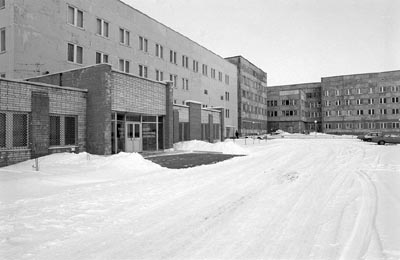
In foreground, Balakovo nuclear power plant personnel training center.
Establishment of the Balakovo Training Center. Beginning in 1993, Balakovo instructors received extensive courses in the Systematic Approach to Training, a methodology adopted at all U.S. nuclear power plants after the 1979 accident at Three Mile Island. Training experts from U.S.-based Sonalysts, Inc., and Brookhaven National Laboratory worked closely with the Balakovo instructors, enabling them to adopt the methods of the Systematic Approach to Training, design training programs, and develop and conduct 12 pilot training courses.
Balakovo instructors presented the first operations and maintenance course in March 1994 and completed the twelfth in April 1997.
Specialists from Balakovo and the United States also developed six general courses: 1) an introduction to the Systematic Approach to Training, 2) general employee safety, 3) instruction skills, 4) supervisory skills, 5) development of plant procedures, and 6) organizational safety culture. Balakovo instructors presented the first of these courses in May 1993 and the last in March 1997.
The United States provided basic equipment, such as computers, software, and copiers, for the Balakovo training center. The United States also supplied equipment for the pilot courses, such as soldering stations, laser alignment equipment, and an electrical operations laboratory.
Training Standards Development. Instructors at the Balakovo training center have evaluated their program, developing performance indicators and an evaluation methodology. Balakovo instructors also have developed a manual that specifies consistent administrative procedures for developing and conducting training courses. Instructors at other Russian plants are using the manual as the basis for developing similar administrative procedures.
U.S. personnel have worked with Russian organizations to modify national training
standards and guidelines to ensure that all nuclear power plant training programs
are based on the principles of the Systematic Approach to Training. Russian
organizations have taken the lead in these activities. The organizations include
VNIIAES, Minatom, Rosenergoatom (REA), Atomtechenergo, Gosatomnadzor (GAN),
and the Balakovo training center.

Instructor Alexander Statnov explains the use of laser alignment
equipment to Kola plant workers in the training center for the plant. Statnov
learned the Systematic Approach to Training with U.S. support.
Transfer of the Training Program to Other Plants. After successfully establishing the pilot training center at Balakovo, U.S. and Russian specialists have worked together to train instructors at Russia's other plants and training centers. In December 1996, a team completed an assessment of the other sites' training needs, practices, resources, and facilities. The survey team included Balakovo personnel, U.S. specialists, staff from the Novovoronezh training center, and representatives from VNIIAES, Minatom, and REA.
To develop a solid foundation for transferring the training program, U.S. training specialists conducted week-long seminars in Moscow for training instructors from the Russian plants and training centers. After this overview, the Russian instructors participated in two one-month courses in the United States that covered the Systematic Approach to Training, instructor skills, and on-the-job training techniques. In addition, participants began developing pilot courses during this training. Over a period of several months, groups of Russian instructors toured a training facility at a U.S. nuclear power plant and received training at General Physics Corporation in South Carolina. A team from General Physics Corporation and Sonalysts Incorporated led the training.
In July 1997, instructors from each of the Russian plants and training centers participated in an instructor skill development workshop at the Novovoronezh training center. U.S. specialists and instructors from the training centers at Balakovo and Novovoronezh conducted the workshop.
Working in pairs, U.S. and Balakovo specialists visited each Russian nuclear power plant three times to work with on-site instructors in developing and conducting a pilot course based on the Systematic Approach to Training. The United States supplied basic and course-specific equipment to each site participating in the expanded training program.
Instructors at Russian plants conducted the first pilot course in September 1997 and the last in November 1998. Each course covered one of the following topics: mechanical maintenance of rotating equipment, skills for shift supervisors, or maintenance of liquid sodium system components (for the Beloyarsk breeder reactor).
In March and April 1998, instructors from the Balakovo plant, VNIIAES, and the Novovoronezh and Smolensk training centers participated in an advanced instructor skills course at the Sonalysts facilities in the United States. The Russian participants will modify the materials from this course for use in an instructor school being established at the Novovoronezh training center.
In April 1998, Bilibino's lead maintenance technician for safety electronics
completed two weeks of training at Russia's Balakovo training center. The topic
was maintenance of the control-and-protection system used at Bilibino. In November
1998, instructors at the Bilibino plant presented two pilot courses. With U.S.
funding, Bilibino workers completed refurbishing and equipping rooms for maintenance
training and course preparation in 1999. The United States supplied room finishing
materials, computers, a server, printers, scanners, copy machines, and a training
television and video recorder.
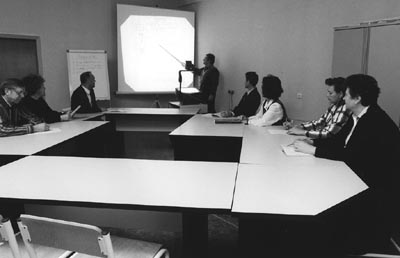
Victor
Shevchenko, instructor, gives a lecture to Novovoronezh plant engineers. The
United States has supported the development of formalized training at this and
other Soviet-designed plants.
In December 1998, instructors from the Balakovo, Novovoronezh, and Smolensk training centers presented a five-day instructor training course for instructors from six Russian plants-Beloyarsk, Kalinin, Kola, Kursk, Leningrad, and Smolensk.
In a second phase of the training technology transfer program, instructors at each plant presented a course in 1999. During workshops at the Novovoronezh training center in April and October 1998, the instructors planned courses based on training materials developed for the Balakovo plant and Ukraine's Khmelnytskyy plant (see section 4.1.1 Personnel Training). Course topics included control room operator skills and the maintenance of motor-operated valves. Experts from the United States and the Balakovo training center worked with instructors on-site as they presented these courses in 1999.
Work in Progress
U.S. and Russian training specialists are developing training for simulator instructors at Russian nuclear power plants.
U.S. and Russian organizations are working together to develop control room simulators for Russian plants. Each simulator, whether full-scope or analytical, must be designed to replicate the configuration and behavior of each individual nuclear power plant.
Activities Completed
Novovoronezh Unit 3. U.S. contractor, GSE Power Systems Incorporated, worked with LAKROM, a Russian subcontractor, to develop an analytical simulator for Novovoronezh Unit 3. The simulator passed site acceptance tests in August and began formal operation in September 1998.
Balakovo Unit 4. GSE worked with LAKROM to develop an analytical simulator for Balakovo Unit 4. The simulator was completed in June 1999. GSE also worked with LAKROM to upgrade an existing full-scope simulator at Balakovo Unit 4, using the system models developed for the analytical simulator. This simulator was completed in November 1999.
Kola Unit 4. GSE worked with VNIIAES to produce a full-scope simulator for Kola Unit 4. GSE provided the computer hardware and software, and VNIIAES provided the system models. The Kola project was completed in March 2000.
Bilibino. GSE and LAKROM developed an analytical simulator for Bilibino,
which replicates the configurations and behavior of the plant's LWGR reactors.
The installed simulator underwent acceptance testing in April 2000 and was formally
turned over to the plant in June.
 |
 |
| The U.S. Department of Energy's Norman Fletcher checks out one of the seven display monitors of a new analytical simulator on a visit to Novovoronezh Unit 3. Plant instructors use the system for training control room operators. |
The full-scope simulator for Kola is
under developement at VNIIAES in Moscow, where electronics experts are
completing assembly. The completed simulator was delivered to Kola in
the summer 1999.
|
Work in Progress
Kalinin Unit 2. This full-scope simulator project is a cooperative effort between the U.S. and Russia. The computer hardware and software has been provided by GSE, and VNIIAES is providing the system models and performing the testing. The Kalinin project is scheduled for completion in November 2001.
|
Emergency Operating Instructions and Simulator Training
In June 1997, control room operators at Novovoronezh Unit 3 used symptom-based emergency operating instructions to restore reactor safety after the emergency feedwater supply was activated. Afterward, the shift supervisor wrote the following account for U.S. specialists who supported the development of the plant's emergency operating instructions: I would like to inform you of my personal opinion regarding the symptom-based emergency operating instructions. On June 18, 1997, the emergency feed-water supply of the primary circuit was actuated. As a result of this event, the control room #3 personnel under my charge have, for the first time at the Novovoronezh nuclear power plant, used the symptom-based emergency operating instructions to restore Unit safety, including monitoring of the critical safety functions. The use of the symptom-based instructions has decreased the psychological stress aroused during the Unit emergency situation. After addressing ourselves to the instruction A-0 and starting actions in accordance with this instruction, we felt the first relaxation and calm. It is possible that the reason for the quietness was the previous simulator training at the Training Center, but we have not met any difficulties while performing operations regarding the instructions A-0 and A-1.1. After the performance of the diagnostics, we turned quietly to the normal operating instructions. Thus, we can claim a significant benefit to the personnel when working with the symptom-based operating instructions. -V.M. Brizitsky |
6.1.3 Emergency Operating Instructions
During an emergency, nuclear power plant operators must stabilize the reactor quickly. Symptom-based instructions, now used at all U.S. plants and many others around the world, enable operators to respond quickly to emergencies without first determining the cause.
Host-country specialists have adapted symptom-based emergency operating instructions for use at Soviet-designed reactors. Multi-country working groups were assigned to each of the four major types of Soviet-designed reactors-the RBMK and the three VVER models. These groups worked with staff from nine reactors that serve as pilot sites.
U.S. experts are working with host-country specialists to perform the necessary analysis to validate the symptom-based emergency operating instructions, ensuring that they will mitigate the consequences of an accident.
Activities Completed
Operators at Novovoronesh Unit 3, a VVER-440/230 reactor, implemented a complete set of symptom-based emergency operating instructions in January 1998. Specialists have drafted complete sets of instructions for Balakovo's VVER-1000 reactors, Kola's VVER-440/213 reactors, and Leningrad's RBMK reactor.
The analysts for plants with VVER reactors have completed drafting scenarios, which include the most severe challenges to plant safety, called bounding scenarios. These will be used in an analytical process to validate the emergency operating instructions, thus ensuring their effectiveness.
Leningrad plant has committed to complete the emergency operating instructions
and draft technical justification documents using analysis and other technical
information provided by the Leningrad in-depth safety analysis (for details
see Section 6.3.1) with technical assistance provided by the Kurchatov Institute.
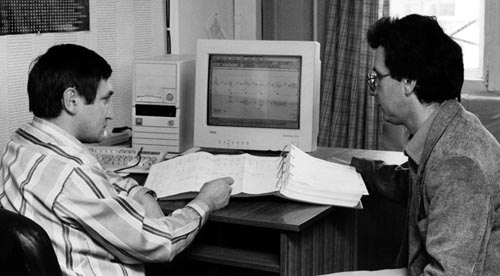
A.
Danilov and P. Medvedev work to verify emergency operating instructions at the
Kola plant. The symptom-based instructions enable operators to respond to emergencies
rapidly without first determining the cause.
Work in Progress
U.S. experts are assisting the Leningrad plant and Kurchatov Institute with a series of integrated activities involving the Leningrad safety assessment staff and training departments. The combined team will provide a technical justification for their emergency operating instructions and assist with related implementing tasks. Leningrad's site-specific simulator also will be available soon to support a broad spectrum of emergency operating instruction tasks.
U.S. experts also are assisting staff at the Balakovo, Kola, and Novovoronezh plants to complete the analytical validation of their emergency operating instructions. Rosenergoatom is providing the leadership role for this analytical validation. Pilot plants, GAN, REA, Gidropress, Atomenergoproekt, and VNIIAES will all participate in this activity.
Novovoronezh plant also is working toward revising the Unit 3 emergency operating
instructions to be applicable to Unit 4. They also will participate in the analytical
activities mentioned above.
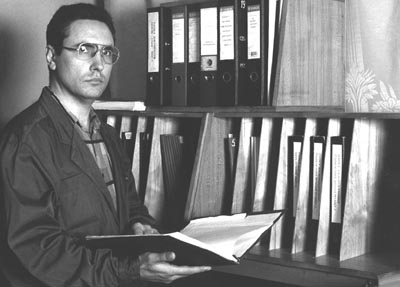
Plant operator Sergey Ostanin checks the emergency operating
instructions in the control room at Novovoronezh. Operators implemented the
instructions in January 1998 at Unit 3.
6.1.4 Configuration Management
U.S. personnel are working with personnel from REA and the Novovoronezh plant to develop a configuration management system for Novovoronezh.
Activities Completed
In 1997, Parsons Power provided configuration management training for key Novovoronezh managers. The managers visited a U.S. nuclear power plant to observe the use of configuration management databases. Earlier in 1997, Parsons staff conducted a detailed assessment of the plant and made recommendations for establishing the configuration management system.
During 1998, Russian personnel drafted a set of configuration management procedures, identified the computer hardware needed to implement a configuration management system, and developed technical specifications for the software needed.
U.S. and Russian specialists also developed a configuration management dictionary, defining or, when necessary, creating common technical terms in both languages.
In 1999, the United States delivered two databases for commitment tracking
and document control to Novovoronezh for use in configuration management processes.
U.S. specialists worked with the Russian team to populate the databases with
the Russian regulatory and design requirements.
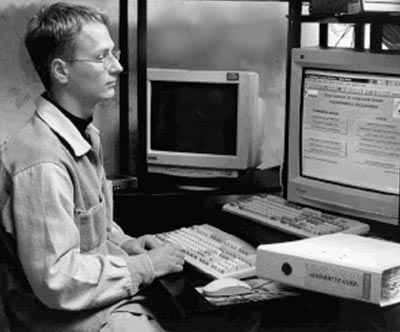
German
Kashey, computer expert at the Novovoronezh plant, uses a configuration management
system provided by the United States. Configuration management ensures that
a plant's physical configuration remains in keeping with its safety design basis.
Work in Progress
In 2000, the United States worked with the Novovoronezh and Balakovo plants along with REA to develop the specifications for a master equipment list for nuclear power plants. When completed, the specifications will guide development of a generic master equipment list suitable for use at all the Soviet-designed plants. Creation of the software for the equipment list is being contracted to a Russian software firm. Pacific Northwest National Laboratory and Parsons will provide mentoring and technical support in the development and testing of the list.
With U.S. support, Russian nuclear specialists are developing a reliability database for the country's RBMK and VVER reactors compatible with a Ukrainian database (see Section 4.1.8). Information from the two databases will be combined and made available to all Soviet-designed reactors. The database, which includes maintenance and operational data regarding failure rates, repair times, and unavailability for components of systems essential to safety, effectively supports the scheduling of preventive maintenance. The database is being designed to interface with the World Association of Nuclear Operator's EPIX database on equipment reliability.
Activities Completed
In 1997, the United States delivered computer equipment to VNIIAES for developing the database and Russian specialists participated in training on EPIX.
Russian specialists completed the design of the database structure in 1998 and installed a local area network at VNIIAES. The network enables personnel at Russian nuclear power plants to access and contribute to the database. Three pilot plants-Balakovo, Kola, and Kursk-initially will be linked to the network.
In May 1998, staff from Pacific Northwest National Laboratory, Science Applications Incorporated, and Energoatom presented a workshop on collecting reliability data. Personnel working on the Russian and Ukrainian databases participated, including staff from Russian and Ukrainian plants, VNIIAES, and Information Technologies Incorporated. Representatives of the organizations involved formed an advisory group to ensure consistency in data collection and reporting.
In June 1998, Russian specialists completed a software quality assurance plan to be used in the development and operation of the database.
In September 1998, Russian specialists began converting historical reliability data stored at VNIIAES into a format that can be used in the database. VNIIAES personnel participated in training on the use and administration of the local area network. The three pilot plants received U.S.-provided computer equipment for accessing and contributing to the database.
In October 1998, Russian specialists began entering historical data from VNIIAES, data from Russian plants, and data from Slovakia's Nuclear Power Plant Research Institute. In December 1998, they completed the collection of existing data from Russian plants and defined procedures and standards for collecting additional data.
In 1999, workers installed additional telecommunications equipment needed to establish electronic connections between plants and the database. During 1999 and into early 2000, Russian specialists worked to define common events and components and to map these to the nomenclature and definitions used at each of the nuclear power plants.
In March 2000, representatives from VNIIAES and the World Association of Nuclear Operators' Moscow Center agreed that any country with Soviet-designed reactors could receive data from the database by agreeing to share their reliability data. Plants outside Russia will access the database through the association's Moscow Center.
Work in Progress
In late 2000 and into 2001, Russian specialists will work to provide each of the nuclear power plants with applications to automate the collection of reliability data at each of the facilities. Russian specialists will continue to collect and analyze reliability data on safety-related components at Russian reactors and will eventually compare and share this data in the host countries of Central and Eastern Europe as well as Ukraine. The project will be complete in September 2002.
6.1.6 Nondestructive Examination
The United States is supplying equipment for finding flaws in primary circulation and safety engineered piping systems and transferring technology for mitigating stress corrosion cracking in piping systems. Technicians use ultrasonic, x-ray, and eddy-current equipment for "nondestructive examination," which enables them to evaluate pipes for tiny flaws and cracks without cutting the pipes open. (For details, see box: Equipment Finds Pipe Flaws Before They Cause Problems, Section 2.)
Activities Completed
Nondestructive examination equipment was delivered to the nuclear power plants in Russia between January and March 1999.
The first meeting of the International Atomic Energy Agency Extrabudgetary Program on Mitigation of Intergranular Stress Corrosion Cracking (IGSCC) in RBMK Reactors was held in May 2000 in Vienna, Austria. The objective of this program is to help the countries operating RBMK reactors establish effective programs for mitigating IGSCC in the austenitic stainless steel piping. The United States is providing technical experts and assistance for the activity.
Work in Progress
The United States will continue to work with the International Atomic Energy Agency along with the Russian, Ukrainian, and Lithuanian specialists to develop a comprehensive program for mitigating IGSCC in nuclear power plant piping. Specifically, the United States is assisting in the following areas:
- providing improved capabilities for inspecting and characterizing cracks
- training plant personnel in effective mitigation and repair techniques
- providing capabilities for monitoring and adjusting water chemistry.
6.1.7 Safety Maintenance Technologies
U.S. specialists have worked with RBMK managers to identify maintenance tools that will significantly improve safety. The United States began supplying that equipment in 1996. In addition to providing state-of-the-art maintenance tools and technology, this program also focused on improving the training of the maintenance personnel. Support was provided to the Kursk, Leningrad, and Smolensk plants and the Smolensk Training Center in Russia, along with the Chornobyl plant in Ukraine and the Ignalina plant in Lithuania. Some safety maintenance technology and training also has been provided to Bilibino plant in Russia, which is an LWGR-12 design rather than an RBMK design.
Activities Completed
Pipe Lathe/Weld-Preparation Machines. The United States supplied a pipe lathe/weld-preparation machine to each of the RBMK sites in 1996. Precision cuts with this equipment improve weld integrity, thus reducing the risk of cooling water leaks. Prior to receiving this equipment, workers cut pipes by hand.
In June 1997, the Leningrad plant requested a second pipe lathe/weld-preparation
machine. The United States delivered the machine in August, in time to be used
during an outage of the Unit 4 reactor. The plant has since purchased two more
machines from the U.S. manufacturer.
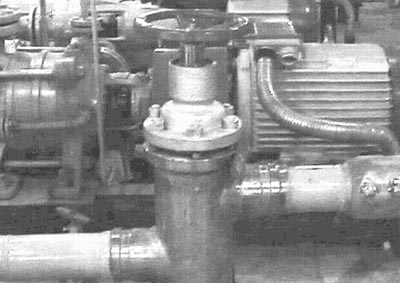
Valve-seat resurfacing equipment allows plant workers at
RBMK sites to repair valves without having to remove them from piping systems.
Valve-Seat Resurfacing Equipment. The United States delivered valve-seat resurfacing equipment to each of the RBMK sites in August 1997, and U.S. specialists trained plant workers in its use. The equipment enables technicians to accurately repair leaking valves without having to remove them from piping systems. This practice increases the accuracy of repairs, reduces maintenance time, and maintains the integrity of pipes.
Vibration Monitoring and Shaft Alignment Systems. In October 1997, technicians at all RBMK sites received training in the use of vibration monitoring and shaft alignment equipment. The United States supplied equipment to Russia's Smolensk training center and to each of the RBMK sites. Workers use the equipment to detect and correct imbalance and shaft misalignment in rotating machinery such as pumps, motors, and turbines.
Bolt-Stress Analysis Equipment. Early in 1999, the United States delivered bolt-stress analysis equipment to the Leningrad and Smolensk plants and provided training in its use.
Technicians use bolt-stress analysis equipment to ensure the proper amount of torque on bolts that hold down valves, pumps, and turbine casings. Bolts with improper torque can shear or break loose, causing equipment damage and leaks.
Infrared Thermography Equipment. Early in 1999, U.S. specialists trained technicians at Russia's RBMK sites to use infrared thermography equipment. Technicians use the equipment to detect hot spots in electrical systems, identifying hazards that could lead to equipment failure and loss of power.
Insulation Analysis Equipment. Early in 1999, the United States delivered insulation analysis equipment to Russia's RBMK sites. Workers use the equipment to detect breakdown of the insulation inside the plant's main generators and around high-voltage lines and equipment, such as the transmission lines between site transformers and the main generators. Detecting and correcting insulation breakdown can prevent loss of electrical power to the reactor.
Thermo-Mechanical Training Loop. In May 1998, workers completed installation of a thermo-mechanical training loop at the Smolensk training center. The loop includes piping, valves, pumps, heat exchangers, and controllers that simulate the mechanical, electrical, and control-and-protection systems of a nuclear power plant. The loop provides hands-on training for mechanics, pipefitters, electricians, instrument specialists, welders, millwrights, and radiation technicians. The loop also can simulate scenarios that require coordinated efforts.
General Energy Technologies, a joint venture of VNIIAES and U.S.-based GSE Power Systems Incorporated developed and installed the training loop.
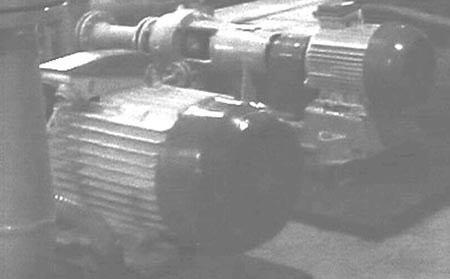 |
 |
 |
| Vibration monitoring and shaft alignment equipment will help maintain the approximately 2000 high-speed pumps per reactor unit. | Equipment for analyzing the torque on bolts can pervent bolts from shearing and causing leaks or equipment failure. | The thermo-mechanical training loop provides hands-on training for maintenance technicians at the Smolensk training center. |
Training Facilities. With U.S. funding, host-country workers in 1997 refurbished and equipped rooms at each RBMK site and the Smolensk training center for maintenance-worker training. The sites previously lacked adequate facilities for training maintenance workers.
Computer Server. The United States delivered a computer server to the Smolensk training center in 1997. The server supports training maintenance personnel on Smolensk's control system. The control system allows operators to determine which plant systems are undergoing maintenance and whether backup systems are available-information critical in an emergency. With the server in place, a plant crew can be trained at the center and software upgrades can be tested there, leaving the controls system at the plant free for shift use.
Safety Maintenance Technologies at Bilibino. At a meeting in the United States in November 1997, U.S. and Bilibino specialists identified high-priority equipment needed for plant maintenance and training. Also in November, five maintenance technicians from Bilibino participated in a three-day workshop in Anchorage, Alaska, on issues related to corrosion in cold climates. The United States has shipped infrared thermography equipment to Bilibino, including an infrared camera and computer analysis equipment. The equipment examines electrical and mechanical systems for heat leaks, which indicate equipment malfunctions. Bilibino received the equipment in late summer, 1999. Early in 2000, additional high-priority safety maintenance technologies (vibration sensing and analysis equipment and laser alignment equipment) were received at the Bilibino site. Also in 2000, in situ, valve-repair equipment was purchased for delivery to the Bilibino site.
Late in 1999, satellite-based communications devices (telephone terminals) were delivered to Bilibino. The devices will enable plant personnel to exchange safety and maintenance information regularly with U.S. and Russian nuclear specialists. In case of a nuclear accident, the telephone terminals also can serve as an emergency early-warning system. The telephone terminals have been activated, and U.S. specialists have provided the telephone numbers to representatives of the state of Alaska.
Work in Progress
Safety Maintenance Technologies at Bilibino. The in situ, valve-repair equipment has been shipped to REA for delivery to the Bilibino site. U.S. specialists expect to provide on-site training to Bilibino staff in the use of all specialized equipment in spring 2001.
6.1.8 Kalinin Local Crisis Center
The United States has supported Russian efforts to establish an emergency response facility at the Kalinin plant.
Activities Completed
In March 1996, a Russian team from VNIIAES and REA participated in a workshop on emergency response facilities at U.S. nuclear power plants. The team drafted an emergency preparedness document and functional specifications for setting up the facility. The United States also supplied office equipment and computers to support this facility. In September 1997, U.S. specialists reviewed and commented on the specifications.
In addition, the United States replaced the plant's aging gamma spectrometer system with a new system. Technicians use gamma spectrometer systems to analyze environmental samples for radioactivity. Such environmental sampling is an essential part of managing nuclear plant emergencies.
Historically, much of the daily business of operating nuclear power plants in the former Soviet Union was based on the knowledge and experience of individual operators. To improve the safety culture in Russian plants, U.S. and Russian nuclear specialists have developed procedures that prescribe specific actions to follow for routine operations.
In 1993, a working group began writing conduct of operations procedures for Russian plants. The group was composed of representatives from host plants, nuclear energy agencies in Russia, U.S. industry, the Institute of Nuclear Power Operations, and the Department of Energy.
Activities Completed
By 1996, the working group had drafted 16 standard guidelines for preparing procedures for management and operational controls. The specialists based the procedures on the "Good Practices Standards" of the Institute of Nuclear Power Operations and on information from U.S. experts. In 1996, the World Association of Nuclear Operators began monitoring progress in implementing the procedures and facilitating communication about lessons learned.
Balakovo is Russia's pilot plant for developing plant-specific procedures based on the standard guidelines. Balakovo has developed and is using 12 plant-specific procedures. Once procedures were developed and tested, REA made any necessary modifications to the standard guidelines and distributed them to other plants for use in developing their own procedures. REA has approved and issued 14 final guidelines to other Russian plants and is working toward full implementation at all Russian nuclear plants.
In the former Soviet Union, nuclear power plant personnel had few opportunities to learn from their counterparts in other nations. To improve the sharing of information, the Institute of Nuclear Power Operations and the World Association of Nuclear Operators began sponsoring operator exchanges in 1989. The exchanges enabled Russian personnel to observe U.S. approaches to safe operations and then adapt these practices at their plants. Most visits focused on training, conduct of operations, and symptom-based emergency operating instructions.
From 1995 to early 1997, the Department of Energy funded additional exchanges. During that time, 76 staff members from eight Russian plants and nuclear organizations visited 11 U.S. nuclear power plants to observe and discuss safe reactor operations. The Institute of Nuclear Power Operations evaluated the benefits of these visits and found that visitors adapted at their own plants policies and procedures they had observed at U.S. plants. In March 1997, Novovoronezh personnel visited the Vermont Yankee plant, concluding the planned exchanges. Personnel from Soviet-designed plants still visit U.S. plants to support specific safety improvement projects.
^top
Engineering and Technology Projects
U.S. and Russian specialists are developing systems for giving plant operators crucial, real-time information needed to correct abnormal conditions. The United States is transferring equipment, training, and procedures to address other risks at Russian plants. Engineering and technology projects in Russia include:
- Safety Parameter Display Systems
- Safe-Shutdown Analysis
- Fire Protection
- Confinement of Radioactive Materials
- Direct-Current Power Systems
- Circuit Breaker Technology Transfer
- Emergency Water Supplies
- Valve Performance
- High-Temperature Clothing
- Ultrasonic Test Equipment.
6.2.1 Safety Parameter Display Systems
When an abnormal event occurs at a nuclear power plant, safe resolution requires a rapid, effective response. U.S. and Russian specialists are developing safety parameter display systems to give control room operators the information they need in emergencies.
A safety parameter display system collects safety information from thousands of sensors in reactor systems and displays the information on workstations in the control room and other plant locations. The system enables operators to assess conditions rapidly and take quick corrective actions.
U.S. and Russian specialists are working to develop safety parameter display
systems for Soviet-designed nuclear power plants. The United States also is
working with Russian specialists to develop symptom-based emergency operating
instructions (see Section 6.1.3). When a safety parameter display system indicates
abnormal conditions, the emergency operating instructions specify the actions
to take.
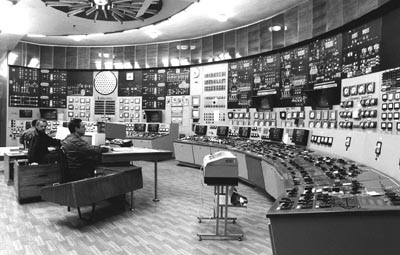
Alexander Korenev, Novovoronezh Unit 3 shift supervisor (center),
sits in front of one of the safety parameter display system monitors during
an outage.
Activities Completed
Kursk Unit 2. In 1997, control room operators at Kursk Unit 2 began using the first safety parameter display system developed for a Soviet-designed RBMK reactor. Westinghouse Electric Company and RDIPE collaborated on design and production of the system, and U.S. contractor Parsons Power Group coordinated the project.
Although plans called for 10 additional safety parameter display system units to be installed at the other Russian RBMK reactors, political issues interrupted the project in February 1999, and the project was subsequently cancelled in 2000.
A second U.S.-Russian team collaborated to produce systems for two VVER-440/230 reactors at the Novovoronezh plant. ConSyst, a Russian design organization, worked with U.S.-based Science Applications International Corporation to design the equipment and prepare it for installation. Burns & Roe coordinated the projects.
In October 1998, plant workers completed site acceptance testing for the Novovoronezh Unit 3 system and plant operators began using it.
In July 1999, plant workers completed site acceptance testing for the Novovoronezh Unit 4 system and plant operators began using it, and in 2000, workers initiated activities to install a similar system in Novovoronezh Unit 5, a VVER-1000 reactor.
|
Work in Progress In mid-2001, workers will install and test a safety parameter display
system at Novovoronezh Unit 5. Konstantin Brezhenko, an engineer at the Novovoronezh plant, checks the data collection system for the safety parameter display system installed in Unit 3 during 1998. |
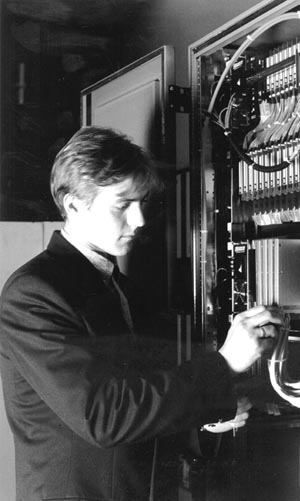 |
A safe-shutdown analysis identifies ways to reduce the risk that fire could damage the systems needed to shut down a reactor safely. To ensure safe shutdown in the event of a fire, international standards call for fire zones and backup safety systems. Each fire zone has barriers to prevent the spread of fire to other areas. Each safety system has a backup system located in a different fire zone. If fire damages one safety system, such as the emergency core-cooling pump, a backup pump can be used while operators shut down the plant.
Soviet-designed nuclear power plants, however, were not designed with the concept of fire zones to prevent the failure of backup safety systems. For example, an emergency core-cooling pump and its backup pump might be in the same fire zone. A fire in that zone could disable both pumps. The results could be overheated nuclear fuel and the release of radioactive material.
In a pilot project, Russian specialists from VNIIAES, Atomenergoproekt, and the Smolensk plant are conducting a safe-shutdown analysis at Smolensk Unit 3. U.S. personnel are providing training and review. The United States also has supplied the necessary computer equipment.
Activities Completed
In November 1996, U.S., host-country, and international specialists completed a report entitled Reactor Core Protection Evaluation Methodologies for Fires at RBMK and VVER Nuclear Power Plants. The report defines methodologies for safe-shutdown analyses at the two principal models of Soviet-designed reactors, RBMK and VVER. The text is published in English and Russian, and Russian, Ukrainian, and international experts have endorsed the methodologies.
In December 1996 and January 1997, managers from Russian plants, fire safety engineers, and regulators received training in performing safe-shutdown analyses. In January 1997, Russian managers and nine Russian analysts participated in training courses on the use of the safe-shutdown methodologies.
In August 1997, experts from Bechtel National Incorporated trained Russian analysts to collect and evaluate existing plant data for a pilot safe-shutdown study at Smolensk Unit 3. In January 1998, the United States provided a computer program, REVEAL_W2, for use in the safe-shutdown analysis. The program develops a model of the plant that shows the fire zones and, within each zone, the safety systems and cables for electricity, instrumentation, and control. Looking at each zone in turn, the program assumes that a fire has disabled the safety systems within that zone. The program then determines whether backup systems in other fire zones could perform the functions necessary to shut down the plant safely. If not, analysts identify the necessary changes, such as moving equipment or rerouting cables. U.S. contractor, Scientech, markets the software, and a team from Brookhaven National Laboratory and the University of Maryland adapted it for use at Soviet-designed reactors.
In January, February, and July 1998, the U.S. team provided further training in the safe-shutdown methodologies. Russian personnel also learned to analyze electrical circuits for fire vulnerability. In February 1998, fire protection engineers from Bechtel National walked through the Smolensk plant with Russian analysts, teaching them to evaluate plant features in terms of safe-shutdown requirements.
The United States provided two electrical circuit tracer kits during 1998 to determine the paths of concealed electrical cables. Russian analysts completed six task reports that identified the locations of fire-protection features, fire zones, safe-shutdown equipment, and electrical cabling.
The deterministic portion of the analysis was completed and reviewed by the U.S. and Russian coordinating committee in September 1999. The fire risk analysis was completed in October 2000, and the risk and significant vulnerabilities report was issued in December 2000.
Work in Progress
The risk and significant vulnerabilities report has identified and prioritized safe-shutdown vulnerabilities. The recommendations from these reports provide the basis for undertaking the most important plant upgrades. The final summary report for this project is in preparation and is expected to be issued in March 2001.
A fire at a nuclear power plant can be catastrophic to plant workers and the public. Besides endangering personnel, a fire can damage a plant's safety systems, leaving operators unable to shut down the reactor safely. The United States is providing Russian plants with materials and equipment that improve their ability to prevent, detect, contain, and suppress fires.
In 1992, Western visitors to Soviet-designed plants found unprotected electrical circuits, power cables sprayed with flammable insulation, and fire doors made of wood. The United States is supplying materials to prevent fires from occurring and spreading.
Unlike U.S. nuclear power plants, which rely on multiple automatic alarm and protection systems to detect and suppress fire, Soviet-designed plants rely on large brigades of dedicated fire personnel. These brigades need to be able to detect fires reliably and alert staff immediately. They also must have the equipment to fight fires effectively. To meet these needs, the United States is supplying basic equipment for controlling fires.
Activities Completed
Fire Doors. U.S. specialists worked with a Russian company, Atomremmash, to develop expertise in manufacturing highly effective fire doors. Atomremmash produced 400 doors for Smolensk. In 1999, the plant completed installation of the doors.
Fire Detection and Alarm Systems. In 1996, Leningrad workers installed a fire detection and alarm system that serves part of reactor Unit 1. In May 1998, Atomenergoproekt completed the design of a second system to serve Unit 2 and the remainder of Unit 1. Honeywell Corporation produced the equipment. KvArc, a Russian firm, installed the Unit 1 system in a project coordinated by Bechtel. Installation of the Unit 2 system was completed in 1999.
Similarly, a fire detection system was designed by the Russian organization Electrotsentronaladka for the Smolensk nuclear plant. The Cerberus equipment for that system was delivered to the plant in 1999, and installation is scheduled for completion in early 2001.
Fire-Protection Materials. In 1997, Smolensk workers applied a fire-retardant material that seals the room-to-room penetrations through which electrical cables pass. The sealant keeps fire from moving along the length of a cable and spreading from one fire containment area to another. The U.S.-based firm, Promatec, produced the material.
Firefighting Equipment. In 1996, Smolensk received 50 variable-spray hose nozzles, 80 sets of firefighter gear, 80 units of breathing gear, and two compressors for filling the air bottles of the breathing gear. In 1997, U.S. manufacturer Scott Airpack trained Smolensk technicians to maintain the breathing gear.
Communications. In June 1998, U.S.-based firm, ProCom, completed the design of a fire-brigade radio system for Smolensk. The system was installed and became operational in 1999.
Work in Progress
Fire Detection and Alarm Systems. Installation and commissioning of the Smolensk fire-detection system will be completed in 2001.
6.2.4 Confinement of Radioactive Materials
| A reactor's confinement structure is designed to prevent the release of radioactive materials to the environment in the event of a nuclear accident. |
 Yuri Dovgal, head of the equipment shop at the Kola plant, is checking the radiation levels in the confinement system of Unit2, using a radiation monitoring system. The system is designed to signal operators to close isolation valves if the monitors detect high radiation levels. |
Activities Completed
Kola. U.S. and Russian specialists worked together to substantially reduce leaks in Kola's confinement structure. They completed the four-year project in October 1997.
Pressure testing in 1993 identified substantial air leaks in the confinement structure of Kola Unit 2, which could allow radioactive materials to reach the environment in the event of an accident.
The United States provided equipment and instruction for reducing the leakage. Workers sealed seams in the walls, floor, and ceiling of the confinement structure with an epoxy manufactured by Promatec. They also installed U.S.-supplied gaskets to seal doors and hatch covers.
The United States supplied 11 highly efficient, nuclear-grade butterfly valves to prevent the release of airborne radionuclides through the confinement structure's ventilation pipes. In May 1996, workers installed the valves, which can close off the pipes in the event of an accident. Kola workers then performed an integrated leak-rate test that showed substantial reduction in confinement leakage. The workers identified and sealed many of the remaining leakage points.
Kola personnel installed a post-accident radiation monitoring system. Monitors inside the confinement structure continuously measure airborne radiation levels. When the monitors detect high levels of radiation, they send signals to the control room alerting operators to close the isolation valves. U.S. contractor, Victoreen, Inc., worked with Kola engineers to install and calibrate the monitoring system in June 1997.
In September 1997, the United States completed its support of the project by delivering equipment to hold the valves open during scheduled plant outages. This equipment permits workers to purge the air in the confinement structure.
6.2.5 Direct-Current Power Systems
The United States has provided reliable backup power systems to Russia's Kola
and Kursk plants. A backup power system must be available for controlling the
plant and safely shutting down and cooling the reactor when an emergency disrupts
normal electric supplies to the plant.
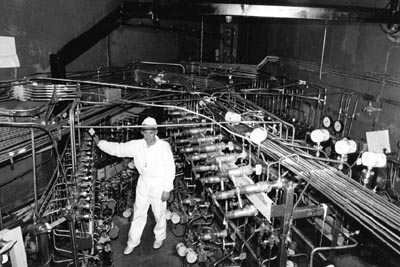 |
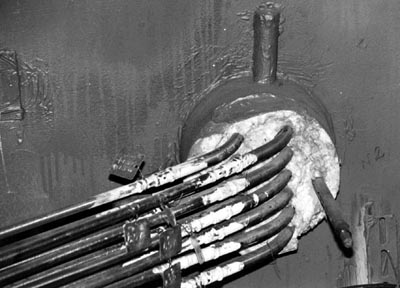 |
|
Plant workers sealed penetrations
where cable and pressure tubes (right) pass through the walls of Kola's
instrument control room. The United States supported the project. |
|
At Kola and Kursk, open-cell glass batteries provided the original backup power system. Cells in the batteries failed often, making the systems unreliable. Large amounts of hydrogen produced during charging created a risk of explosion or fire, which could damage the batteries, endanger plant workers, and threaten reactor safety. Furthermore, the fragile batteries could be damaged in an earthquake, making them unusable when backup power could be essential.
Activities Completed
The United States supplied safety-grade batteries to Kola and Kursk in 1997. U.S. contractor Burns & Roe worked with Kola and Kursk personnel to determine emergency power loads and the battery sizes needed. The batteries are mounted on seismically qualified racks and have an expected operating life of 20 years. Their enclosed cell design permits minimal release of hydrogen gas during recharging.
At Kola Units 1 and 2, workers installed two switchboards and two sets of batteries at each reactor, as well as a fifth set of batteries shared by the two reactors.
At Kursk Unit 2, the original direct-current power supply system supplied power
for both essential and nonessential safety equipment. Workers installed a set
of non-safety-grade batteries and a set of safety-grade batteries to separate
the non-safety loads from the safety loads. GNB Technologies/NLI manufactured
the safety-grade batteries for both the Kola and Kursk plants. Yuasa Exide produced
the non-safety-grade batteries for Kursk.
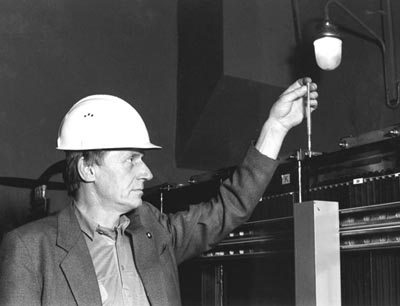
Vladimir Rozhkov, chief of the battery facility, is performing
the daily check of the batteries. The batteries, which provide backup power
for safety equipment, were upgrades to meet modern standards.
In July 1997, U.S. and Russian specialists described their experience in the Kola and Kursk pilot projects at a workshop for representatives of Russian plants. The workshop enabled the Russian representatives to express their interest in the systems supplied to Kola and Kursk and allowed Burns & Roe to assess the Russian market.
In October 1998, representatives from Burns & Roe and Russian manufacturers met in Russia to explore the possibility of business relationships for manufacturing and assembling batteries. Rosenergoatom subsequently concluded that the market for nuclear-grade batteries in Russia did not warrant the development of an in-country manufacturing capability.
6.2.6 Circuit Breaker Technology Transfer
In 1996, REA identified a major safety concern at Russian plants: unreliable 400-volt and 6000-volt circuit breakers. Some circuit breakers have failed to open when a short circuit occurred, causing cables to overheat and catch fire. Failure to close can prevent safety systems from operating when needed.
The United States is working with Russia to develop reliable circuit breakers for Russian plants. For a pilot project at Smolensk, the United States provided 400 replacement circuit breakers. The circuit breakers were purchased from western manufacturers. Russian companies designed and fabricated the associated equipment for installing the circuit breakers into the switchgear already in place at the plant. Bechtel National coordinated the project.
Three types of circuit breakers are being provided: 1) 6-kV circuit breakers; 2) 400-volt high amperage circuit breakers and; 3) 400-volt low amperage circuit breakers.
Activities Completed
In 1997, U.S.-based Colandrea and Associates trained four Russian specialists from REA, GAN, and the Smolensk plant in quality assurance for circuit breaker technology.
In 1999, eighty 400-volt low amperage circuit breakers were provided to Smolensk for in-plant demonstration.
Also in 1999, ten 6-kV circuit breakers manufactured by ABB of Sweden and Merlin-Gerin of France were assembled into racks by the Russian Company ELOX and certified for use at Smolensk. The purchase of the units for in-plant demonstration was initiated in early 2000.
In 2000, certification testing of the 400-volt high amperage assemblies was completed. Negotiations have been completed for the in-plant demonstration phase for these breakers.
Work in Progress
Nineteen of the 6-kV, in-plant demonstration circuit breakers have been purchased and are being installed in racks. The circuit breaker assemblies will be installed at Smolensk during the spring 2001 outage.
In 2001, ten 400-volt high amperage circuit breakers will be purchased, mated with racks supplied by the Russian organization Plant Progress, and installed in Smolensk.
Rosenergoatom will provide an assessment of in-country circuit breaker manufacturing capability.
6.2.7 Emergency Water Supplies
Nuclear power plants must maintain backup water supply systems to ensure a
continuous supply of cooling water to reactor systems. The backup systems at
Russia's older reactors-RBMKs and VVER-440/230s-have been inadequate.
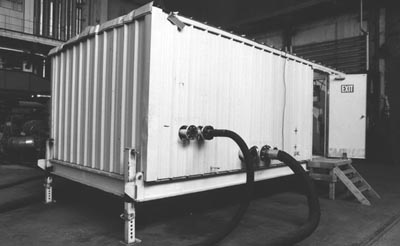 |
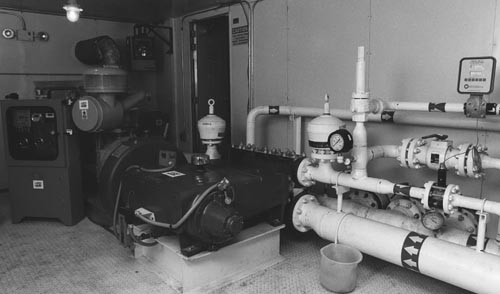 |
|
The emergency water supply pumping
system for Novovoronezh is mobile so that
it can be moved into place if an emergency requires backup cooling water. |
|
Activities Completed
Kursk. The United States provided an emergency water system for the plant in July 1996. The pumping unit is mounted on a trailer and can be moved where needed during emergencies involving loss of cooling water to the reactor core. Once in place, the unit can be connected to an emergency water source by flexible piping. The trailer carries a John Deere diesel generator to provide a power source that is independent of the plant. U.S.-based Godwin manufactured and assembled the pumping unit. Burns & Roe managed U.S. participation in the project.
In 1997, Atomenergoproekt designed plant modifications to enable workers to hook up the emergency water supply system to the plant. In 1998, workers installed a common header, then installed piping between the header and the Unit 1 reactor. During upcoming outages, they will install the piping for Units 2, 3, and 4. U.S. contributions to the project are complete.
Novovoronezh. The United States supplied an emergency water supply pumping system to Novovoronezh. The system passed site acceptance tests in August 1998, and U.S. specialists trained plant personnel to operate and maintain it.
The system is mounted on a trailer and includes its own diesel pump driver and diesel generator. The mobile pump is stored away from the plant in a seismically safe building. Workers can move it into place when an emergency requires backup cooling water.
Atomenergoproekt designed the system, with technical input from Parsons Power. Wheatley-Gaso assembled the system in the United States.
The United States is working with Russia in two areas to improve the reliability of valves at its nuclear power plants. Many valves do not function properly when activated. Others break when activated or damage the valve seats by closing too forcefully. In 1996, U.S. and Russian specialists studied the valves at Russian nuclear power plants and concluded that a large percentage of valve failures are due to inadequate maintenance. Valve monitoring technology is being provided to enable on-line assessment of the condition of valves. Technology transfer is also being provided to enable in-country manufacture of highly reliable valves.
Activities Completed
In January 1998 at Smolensk, representatives from U.S.-based Liberty Technologies Incorporated (subsequently purchased by Crane Company), and Burns & Roe demonstrated the use of a valve monitoring system called VOTES. With the VOTES system, a worker attaches a sensor to a valve, then connects the sensor to the VOTES computer. The system measures thrust as the valve opens and closes. By analyzing the data, a trained technician can detect problems with the valve's mechanical and electrical conditions.
In July 1998 at Novovoronezh, the same representatives trained Russian technicians to install valve sensors and test the valves. Crane, Burns & Roe, REA, and the Russian organization SPLAV intend to establish a business arrangement to provide valve monitoring services within Russia.
In 1999, the United States began a new project to transfer manufacturing technology to the Russian valve manufacturer Chekhov. The U.S. valve manufacturer Target Rock reviewed Chekhov valve designs and made recommendations for improving the fabrication and reliability of the valves. Then, Chekhov manufactured a prototype isolation valve and a prototype relief valve.
Work in Progress
Crane company will provide a final training session to enable Russian technicians to install sensors, and monitor and interpret the results of valve monitors based on the Crane VOTES system. Assistance also will be provided in monitoring the performance of the new valves manufactured by the Chekhov company.
6.2.9 High-Temperature Clothing
Maintenance workers must enter areas near the reactor core to check for leaking pipes. These areas have high temperatures, humidity, and radiation fields. The United States is providing protective clothing for work in these areas, along with portable units for breathing, cooling, and communication. The United States also is providing more flexible protective suits for emergency repairs in humid areas with radioactive contamination and moderate heat. U.S. high-temperature clothing specialists worked with Rosenergoatom to determine specifications for the suits.
Completed Activities
The United States has provided Russian plants with16 safety suits for use in environments with steam and moderately high temperatures. Such suits can be worn when responding to a steam leak in the turbine-generator area of a nuclear power plant. In addition, the United States has provided 12 suits for environments with high temperatures and radiation. These suits can be used for responding to a fire in the reactor. Eight Russian plants received the suits-Balakovo, Beloyarsk, Bilibino, Kalinin, Kola, Kursk, Novovoronezh, and Smolensk. Zaschitnaya Odezhda, a Russian firm, is the manufacturer of the suits for use in environments with high temperatures and radiation. The Russian firm Kentaur Scientific Production Company, Ltd., is the manufacturer of the steam-resistant suits.
6.2.10 Ultrasonic Test Equipment
Russia's nuclear power plants have lacked equipment to check for flaws in critical piping. The United States has provided ultrasonic test equipment to the Kursk plant, along with training in use of the equipment. The United States is providing additional systems for nondestructive examination of reactor components in Russia. (See Section 6.1.6)
Activities Completed
In 1996, the United States provided two types of ultrasonic test equipment: hand-held and automated. The automated equipment is used to inspect areas that are inaccessible while the plant is operating. In 1996, U.S. experts trained Kursk workers to use the equipment. In 2000, additional training was provided to the Kursk staff. Calibration equipment also will be supplied to enable the equipment to be periodically calibrated by the plant staff.
^top
6.3 Conducting In-Depth Safety Assessments
Plant Safety Assessment Projects
Preparation of in-depth safety assessment reports on Russian nuclear power plants is required by new Russian Federation nuclear power regulations for issuing a long-term license. The Russian regulator GAN issued a document entitled Recommendations for In-depth Safety Assessment of Active NP Units with VVER and RBMK Reactors (Standard Contents of ISA Report - RB G-12-42-97) that defines requirements for the assessment and supporting documentation.
Due to this regulation and the need to obtain long-term operating licenses, Russian plants are conducting in-depth safety assessments. A safety assessment consists of probabilistic, deterministic, engineering, and organizational studies supporting conclusions on the overall safety of the plant. Reports conform to the Russian regulations.
6.3.1 Plant-Specific Safety Assessments
U.S. personnel are working with Russian and international specialists to conduct in-depth safety assessments at three plant sites in Russia: Kola, Leningrad, and Novovoronezh. U.S. support includes the transfer of computer codes for safety analyses, training in the use of the codes, guidance in making assessments, and review of completed work by host-country specialists. When the safety analyses are completed, Russian nuclear specialists will assess the safety of the reactors, determine the most significant risks, and identify the most effective safety upgrades.
U.S. safety assessment team members include staff from Argonne National Laboratory, Pacific Northwest National Laboratory, Scientech, and Science Applications International Corporation.
Kola. The Kola in-depth safety assessment project began in spring 1996. Although a need for safety assessments existed at older Units 1 and 2 (VVER 440/230s), plant staff requested assistance in developing a probabilistic risk assessment for Unit 4, a VVER 440/213 unit, as a training exercise prior to proceeding with assessment of the older units.
In addition, a design basis accident analysis was started for Units 1 and 2
and is currently in progress. In the spring of 1999, the plant decided to seek
Western assistance in preparing a probabilistic risk assessment for Unit 2.
At that time, the Swedish International Project and the Norwegian Radiation
Protection authority agreed to join with the Department of Energy to assist
Kola in the study. The Swedish and U.S. organizations formed a partnership with
Kola that included a steering committee and a technical coordinating committee
with all three organizations represented.

Victor Shutov, project leader, works with his colleagues on a probabilistic
risk analysis of Kola Unit 4. The United States provided computer codes and
hardware for the project.
In 2000, the Swedish International Project completed a peer review for the U.S.-supported Unit 4 probabilistic risk assessment as a first step to familiarize Swedish experts with the progress made by Kola staff in absorbing modern safety assessment technology. The Unit 2 probabilistic study is progressing well with U.S., Swedish, and Norwegian assistance.
The participation of the Kola nuclear power plant in the in-depth safety assessment has resulted in improved plant performance, quality assurance, and understanding of international nuclear safety standards.
As a result of the probabilistic risk assessment of Unit 4, the plant identified and prioritized a list of improvements to the facility. In addition, the assessment identified accident scenarios that deserve more study, such as the clogging of the containment sump filter by insulation and other debris once the containment spray system is activated-a concern that applies to other VVER plants as well.
Leningrad. Leningrad plant has committed to conduct an in-depth safety assessment meeting GAN requirements for issuance of a long-term operating license. The Department of Energy, in recognition of this commitment, is assisting Leningrad plant in the development of a safety assessment for Leningrad Unit 2, which is a first-generation RBMK reactor. The Leningrad plant consists of four 1000-megawatt RBMK reactors located on the Gulf of Finland near St. Petersburg, Russia (Units 1 and 2 are first-generation reactors, while Units 3 and 4 are second-generation reactors). In addition to the United States, project participants include Sweden, Finland, Great Britain, and Russia.
Western project participants provide financial and technical assistance to Leningrad plant supporting the safety assessment. The Leningrad project benefits from the technology and experience of a completed probabilistic and deterministic safety assessment at Unit 2, which involved collaboration by Russian, U.S., and British experts.
The in-depth safety assessment consists of probabilistic, deterministic, engineering, and institutional studies supporting conclusions regarding the overall safety of the Unit 2 reactor. Specifically, the assessment provides documented and verifiable reference materials from a broad spectrum of studies that support a conclusion regarding the safety of a unit. The format and content of the reports conform to the requirements of Russian regulation.
The U.S. contribution to the project includes 1) management of project support; 2) assistance in developing the deterministic analysis, system descriptions, database development, and engineering assessments; and 3) the summary reports required. The Unit 2 safety assessment report will be issued to GAN in June 2001. If this project is successfully completed, the project team will consider extending the safety analysis work to Unit 1, the oldest unit on the site.
Novovoronezh. With U.S. support, plant specialists are conducting an in-depth safety assessment of Novovoronezh Units 3 and 4, which are VVER-440/230 reactors. The specialists are documenting plant systems and performing a probabilistic risk assessment and a deterministic safety analysis.
In 1998, the Russian nuclear specialists completed the quality assurance guidelines
for the assessment. They also completed most of the guidelines for conducting
a probabilistic risk analysis that examines abnormal events inside the plant
that could lead to an accident. They later will perform a limited analysis of
events outside the plant that could lead to an accident. Also in 1998, the specialists
completed their collection of data on the reliability of plant components, their
description and documentation of the plant's safety-related systems, and a database
for developing a RELAP5 model of the plant.

Nilolai Sysuev, engineer of the Novovoronezh plant, is using
RELAP5 for an in-depth safety assessment of Units 3 and 4.
The specialists are developing guidelines for a deterministic safety analysis, adapting the guidelines developed at Kola for that plant's VVER-440/230 reactors.
The United States has supplied computer equipment for the in-depth safety assessment, and Argonne National Laboratory is coordinating the project. Science Applications International Corporation is providing day-to-day technical and management support. The Nuclear Safety Institute of the Russian Academy of Sciences (IBRAE) will perform an independent peer review of the work.
An initial version of the in-depth safety assessment report was completed in December 2000. This draft version of the report will undergo review and revision, and the final report is scheduled for completion by the end of 2001.
6.3.2 Transfer of Safety Assessment Capabilities
With U.S. support, Russian nuclear specialists are developing the expertise to conduct plant safety assessments. U.S. personnel are training Russian specialists to validate and use U.S.-developed computer codes for safety analyses. Russian personnel participate in U.S.-sponsored forums and workshops for exchanging information on assessments at Soviet-designed reactors.
Activities Completed
RELAP5 Transfer and Training. The Nuclear Regulatory Commission has transferred the RELAP5 computer code to two Russian organizations, IBRAE and the Electrogorsk Research Center for Nuclear Power Plant Safety.
RELAP5 is an important tool in plant safety analyses. The code is used to create a computer model of a specific plant's thermal-hydraulic system, including the reactor core, reactor pressure vessel, piping, and steam generators. The code then uses the computer model to simulate accident scenarios and predict the progression of various emergencies involving the thermal-hydraulic system and the temperatures in the reactor core.
In 1997, specialists from Russian plants and nuclear safety organizations participated in four four-week training sessions on the RELAP5 code. Hands-on exercises illustrated the use of the code for performing thermal-hydraulic analyses of Russian reactors. Staff from the Idaho National Engineering and Environmental Laboratory and Argonne National Laboratory led the sessions.
Information Exchanges. The United States has sponsored international forums and workshops for exchanging information on in-depth safety assessments at Soviet-designed reactors. The International Atomic Energy Agency and the Swedish International Project on Nuclear Safety also have supported this effort.
Five forums focusing on analytical methods and computational tools for conducting assessments have been held. The first forum was in September 1996 in Obninsk, Russia. Representatives of 10 Soviet-designed nuclear power plants were among the 75 specialists attending from around the world. Forums have continued each year in Obninsk, in September 1997 and in October 1998, 1999, and 2000. The international forums now host more than 100 participants from a dozen countries.
Two smaller workshops have focused on probabilistic safety analyses at VVER reactors. The first workshop, held in November 1996 in the Czech Republic, enabled participants to discuss such issues as loss-of-coolant accident frequencies and component reliability data. The participants-from Russia, Ukraine, the Czech Republic, Hungary, and Slovakia-requested a follow-up session.
The follow-up session, held in April 1997 in Bratislava, Slovakia, focused on improving a generic methodology for structuring and collecting data for plant-specific risk analyses. Participants came from Russia, Ukraine, the Czech Republic, Hungary, Slovakia, Romania, Holland, and Spain.
Safety Analysis Training at Bilibino. In May 1998, a Bilibino engineer received training at the Pacific Northwest and Oak Ridge national laboratories on options for storing spent nuclear fuel, including use of the SCALE computer code. The code performs calculations for spent-fuel storage. Bilibino's spent-fuel storage capacity is limited, and the plant is exploring long-term storage options.
Containment Analysis
With U.S. support, IBRAE staff have analyzed the tendon stress of the containment
structure around Kalinin's reactor Unit 1. They recommended procedures for improving
the reliability of the containment structure by reducing tendon stress.
Soviet-designed VVER-1000 reactors have containment structures to keep radioactive materials from being released to the environment during an accident. The structures are made of concrete, reinforced by a web of steel tendons to which tension has been applied. The degree of tension on the tendons helps determine how well the structure can withstand the high pressure and heat from an accident. An earlier study indicated that the performance of the containment structures at VVER-1000 reactors could be improved by modifying their tendon stress.
In July 1998, IBRAE staff completed an analysis of tendon stress in the containment structure for Kalinin Unit 1 and demonstrated that reducing the stress would improve containment reliability. In August 1998, IBRAE sent its recommendations to GAN on specific procedures for modifying the tendon forces. Argonne National Laboratory staff provided technical support for the project, and Argonne and GAN have reviewed the recommendations.
6.3.3 Verification and Validation of Computer Analysis Codes
When analysts use RELAP5 and other computer codes in safety analyses, they ensure the codes accurately represent the configuration and predict the behavior of the analyzed reactor. In a process called validation, specialists check the codes against test data. These data are produced by experimental facilities designed to simulate the behavior of a specific type of reactor. In a process called verification, analysts use the safety analysis codes to develop plant models and accident scenarios, then check the models and scenarios against data from actual reactors.
U.S. and Russian analysts are working to validate RELAP5 for use in both RBMK and VVER reactors. In a project coordinated with Swedish analysts, U.S. specialists are working with Lithuanian and Russian analysts to develop benchmark problems for assessing two neutron-kinetics/thermal-hydraulic codes, STEPAN/KOBRA (used in Russia) and RELAP5-3D (transferred for use in Lithuania), for use in RBMKs.
In addition, to gain regulatory acceptance of safety analyses, Russian analysts must certify the codes for use in VVER and RBMK reactors. For certification, analysts validate that the codes accurately predict the physical phenomena and event sequences that would occur in these reactors.
Specialists from IBRAE are working to certify MELCOR for use in safety analyses at Russia's VVER reactors. The United States and REA are funding the project.
Work in Progress
Validation of RELAP5. U.S. analysts are working with Russian analysts to validate the RELAP5 computer code for application to RBMK and VVER reactors. The U.S. and Russian International Nuclear Safety Centers are coordinating the work. (For a description of the Safety Centers, see Section 6.5.2.) The analysts also are coordinating their work with REA and GAN, so the results can be used in Russia's regulatory certification process.
Russian specialists from Minatom, the Kurchatov Institute, and Electrogorsk are validating RELAP5 for RBMK reactors; and analysts from Electrogorsk, the Kurchatov Institute, Gidropress, and the Institute of Physics and Power Engineering are validating the code for VVER reactors.
In January 1998, Russian analysts completed transient phenomena and test prioritization plans for RBMK and VVER reactors. In June 1998, Russian analysts completed a plan that identified and prioritized a list of standard problems to be tested with RELAP5. In August 1998, Russian and U.S. analysts completed the definition and analysis of the first of these problems.
In December 1998, a U.S. instructor presented a training course on procedures for code configuration control and maintenance. These procedures govern modifications to a code. As analysts modify a code to replicate the physical phenomena and event sequences of a particular reactor, they use the procedures to guide, track, document, and test the code modifications. Analysts from Electrogorsk, the Kurchatov Institute, RDIPE, and the Russian International Nuclear Safety Center participated in the course, which was held in Moscow.
The validation work is scheduled for completion in 2001.
Assessment of STEPAN/KOBRA and RELAP5-3D for RBMK reactors. To validate the STEPAN/KOBRA and RELAP5-3D safety analysis codes for application to RBMK reactors, specialists from the Lithuanian Energy Institute are working with Russian analysts from the Kurchatov Institute. The specialists are developing benchmark problems for RBMK transients with spatial reactivity effects. They will analyze the problems with the Russian-developed STEPAN/KOBRA code and the U.S.-developed RELAP5-3D code, then make code-to-code comparisons. Under Swedish sponsorship, analysts from the Royal Institute of Technology in Sweden also will analyze the benchmarks and will provide technical support in neutron kinetics to the Lithuanian Energy Institute. This code assessment work is scheduled for completion in early 2001.
Thermal-Hydraulic Test Facility. International engineers are developing a test facility that simulates the thermal-hydraulic behavior of a VVER-1000 reactor. The facility in Electrogorsk, near Moscow, will be used to validate safety analysis codes. U.S. and Russian engineers are working on the project with personnel from the Nuclear Energy Agency of the Organization for Economic Cooperation and Development.
The United States is providing instruments for the facility. U.S. personnel have redesigned and tested instruments previously used in the United States and prepared them for shipment to Russia. They will be shipped when the Russian customs committee approves delivery.
Code Certification. In 1997, IBRAE specialists identified GAN requirements for certifying the MELCOR and RELAP5 codes. In January 1998, IBRAE completed a plan for certifying MELCOR for use at VVER reactors. In February 1998, IBRAE completed a plan for certifying MELCOR for use at RBMK reactors and, in August 1998, also completed plans for certifying RELAP5 for use at RBMK and VVER reactors.
In April 1998, IBRAE specialists began the process of validation, accident scenario analysis, and document preparation required to achieve GAN's certification of MELCOR for use in safety analyses at VVERs. In June 1998, GAN's Scientific and Engineering Center accepted the certification plans for MELCOR use at VVERs. This acceptance enables IBRAE to conduct further work toward certification. In September 1998, IBRAE completed a report presenting the principles for using MELCOR to model a VVER reactor.
To model a reactor, analysts enter information based upon engineering designs and experiment results. MELCOR uses this data to create a computer model of the reactor's cooling system and containment building. The model then simulates severe accident scenarios.
IBRAE staff have begun collecting the data and developing MELCOR input models of two types of VVER reactors-VVER-1000 and VVER-440/213. When the models are complete, the analysts will check them against data from actual operating VVER reactors to validate that the models accurately represent and predict their behavior. Upon completion of the work, the analysts will submit their results to GAN for review and certification of MELCOR's use at VVERs.
^top
6.4 Developing an Institutional and Regulatory Framework
Nuclear Safety Institutional and Regulatory Framework Projects
U.S. personnel are working with Russian authorities to develop a strong institutional framework for regulating Soviet-designed nuclear facilities. The objective is to ensure nuclear safety by promoting a strong, independent body able to regulate nuclear activities.
U.S. efforts also promote host-country adherence to international nuclear safety treaties and liability conventions. Effective exchange of nuclear technology requires such adherence, consistent with internationally recognized safety, environmental, and health standards.
To accomplish these objectives, staff from three U.S. national laboratories-Pacific Northwest, Argonne, and Oak Ridge-are working in close cooperation with the Nuclear Regulatory Commission and Russian regulators.
6.4.1 Capability Enhancement for Russian Regulators
In June 1995, U.S. and GAN representatives agreed to work together in developing a strong, independent nuclear regulatory infrastructure in Russia. U.S. personnel have provided training for GAN inspectors, and U.S. and Russian personnel exchanged information and analytical tools.
Activities Completed
In 1996, GAN personnel participated in workshops on quality assurance and safety analysis for fuel cycle facilities. GAN personnel also observed U.S. emergency preparedness exercises.
U.S. instructors presented seven workshops in 1997. In April, GAN specialists participated in a workshop on safety analysis for fuel cycle facilities. In June, 35 GAN staff members representing all the regional offices of the agency participated in a workshop on inspection techniques. Also in June, U.S. personnel presented the third in a series of workshops on quality assurance for fuel cycle facilities. In August, GAN personnel attended a course in criticality safety for fuel cycle facilities. In September, GAN staff participated in a course on decontamination and decommissioning of nuclear facilities. In October, GAN personnel attended a sequel to the April workshop on safety analysis techniques and regulatory issues for fuel cycle facilities. In November, GAN staff attended a workshop on the systematic approach to training.
In February 1998, two GAN specialists worked with staff at Department of Energy headquarters for four weeks, studying the Department's system for analyzing abnormal operational events at its facilities. Under the system, Department personnel share information to improve operations, identify adverse safety trends, and allocate oversight resources.
In April 1998, 24 nuclear safety inspectors from GAN attended a Moscow workshop on conducting radiation protection inspections. Specialists presenting the workshop came from Pacific Northwest National Laboratory and the Department of Energy.
GAN representatives participated in a June 1998 workshop in Washington, D.C., developing a radiation protection inspection plan. The Russian specialists then field-tested the plan by inspecting hot-cell facilities at Argonne National Laboratory West in Idaho Falls, Idaho.
In August 1998, 20 nuclear safety inspectors from GAN received training in fire protection and chemical process safety. Specialists from Science Applications International Corporation, Factory Mutual, and the Department of Energy conducted the workshop in Moscow. Personnel from GAN's Scientific and Engineering Center began translating nuclear safety documentation.
In October 1999, an Event Reporting and Analysis Workshop was held in Moscow. The workshop was to follow up on the February 1998 workshop to help GAN develop its own capability for reporting and analyzing operational events at nuclear facilities under its regulation.
In April 2000, a Spent Fuel Management Workshop was held in St. Petersburg, Russia, to discuss licensing and safety issues associated with spent fuel storage for nuclear power plants, research reactors, and naval and civilian marine nuclear propulsion.
6.4.2 Liability Protection
U.S. technical specialists are supporting the Department of Energy in seeking international approval of a treaty that would channel liability to the responsible operator of a Soviet-designed nuclear facility. Such liability arrangements are customary in the United States and Europe. The treaty also would cap the liability of contractors in U.S. and foreign courts, if a malfunction or accident occurs at a Soviet-designed nuclear facility where U.S. contractors provided services. This "Supplementary Funding Convention for Accident Compensation" would improve the safety of Soviet-designed nuclear power plants, enabling the use of advanced safety technologies.
The Board of Governors of the International Atomic Energy Agency approved the proposed treaty in April 1997. In June 1997, leaders of the G-7 nations issued a communique' at their Denver summit on nuclear safety that welcomed the adoption of the proposed treaty.
Diplomats signed the Supplementary Funding Convention in September 1997 at the International Atomic Energy Agency's Diplomatic Conference in Vienna. U.S. Secretary of Energy Federico Peľa signed on behalf of the United States. Russia has not yet signed.
The U.S. cannot accede to the treaty until the Senate gives its advice and consent to ratification. DUMA ratification also is required in Russia.
^top
Projects in Decommissioning and Safety
6.5.1 Decommissioning of Soviet-Designed Reactors
Several Soviet-designed reactors in Russia are approaching the end of their design lives. Leningrad Unit 1 is expected to be the first commercial reactor facility to be decommissioned. U.S. and Russian nuclear specialists have completed two preparatory tasks for decommissioning-they have recommended a decommissioning strategy and developed a corresponding cost estimate.
The recommended strategy is an option that the Nuclear Regulatory Commission calls SAFSTOR. The deactivated facility would be put into safe storage for approximately 70 years, thus allowing short-lived radioisotopes to decay.
At the end of the safe storage period, workers will be able to complete the decommissioning work under lower levels of radiation.
Specialists from Russia's Kurchatov Institute and the Leningrad plant performed the strategy study, with technical support from experts at the Pacific Northwest and Brookhaven national laboratories. The team's report recommended the safe-storage strategy in November 1997.
U.S. and Russian personnel completed an estimate of the cost of decommissioning Leningrad Unit 1 in September 1998. The cost was estimated to be $175 million plus the cost of disposal of radioactive waste and storage of spent nuclear fuel, which were outside the scope of this study. The study used a model originally developed by the Nuclear Regulatory Commission for estimating the cost of decommissioning a boiling-water reactor facility in the United States. Decommissioning specialists adapted the model to represent the economic conditions in Russia and the specific design features of the RBMK reactor. The cost model is applicable to other RBMK reactor facilities.
6.5.2 International Nuclear Safety Centers
The United States and Russia have established International Nuclear Safety Centers for joint research and technology development. The U.S. center, established in Argonne, Illinois, in October 1995, is associated with Argonne National Laboratory. The Russian center, established in Moscow in July 1996, originally was managed by RDIPE for Minatom. In April 1998, the center became a separate legal organization and in May 1999 the center became an independent organization under Minatom. In May 1999, the center opened independent facilities. Experts at these safety centers have undertaken 10 joint projects that focus on significant aspects of the safety of nuclear power.
The experts initiated eight projects in 1997:
- development of databases for safety assessments of nuclear facilities
- measurement and review of materials property data
- compilation of information on Russian nuclear safety computer codes and experiments
- development of advanced coupled neutron/thermal-hydraulics/mechanics codes
- development of accident management technologies for Russian plants
- validation of Russian computer codes for transient analyses of design-basis accidents
- validation of three-dimensional structural analysis software and models
- development of monitoring and diagnostic techniques for sensors, systems, and equipment.
|
Internet Sites Provide Data for International Nuclear Safety The U.S. and Russian International Nuclear Safety Centers have established electronic databases for information on nuclear facilities and nuclear safety. The databases serve three purposes: to offer easy access to information about the world's nuclear facilities; to provide access to up-to-date nuclear safety information, especially material properties data; and to create an electronic forum for U.S. and international specialists to use in safety research collaboration. Development of the databases is ongoing, with the results of collaborative research added as projects are completed. The Internet address for the U.S. database is http://www.insc.anl.gov. |
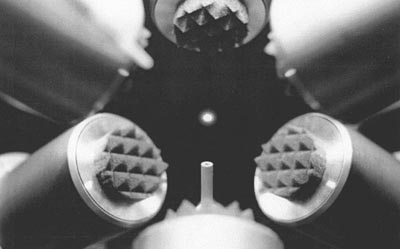 Research apparatus for measuring thermoplastic properties of containerless oxides. Research on metals and oxides is relevant to the analysis of design-basis accidents at Soviet-designed nuclear power plants. |
The experts initiated two additional projects in 1998:
- development of a nuclear safety research and development plan for Minatom
- comparison of lead and sodium properties for reactor cooling.
During 1998, nine Russian specialists worked on technical projects at the U.S. center for periods ranging from two weeks to three months. For six months during 1997 and 1998, a senior representative from the United States worked in residence at the Russian center, participating in start-up activities for the joint projects. The safety centers sponsored 28 technical working meetings during 1998. In addition, U.S. and Russian specialists collaborate regularly through fax, electronic mail, and videoconferencing over the Internet.
The Centers sponsored a one-week technical workshop on severe accident management in Obninsk, Russia, in September 1997. Russian participants came from every sector of the Russian nuclear establishment, including nuclear power plants, government ministries, regulatory agencies, institutes, and private industry. In October 1998, U.S. and Russian specialists jointly presented a paper on coupled thermal-hydraulic and neutronic codes at the International Conference on the Physics of Nuclear Science and Technology in Hauppage, New York.